If you sell it, you should know it, right?
Well, in a previous life, I spent six years selling to, and thereby studying, Sales Operations. And following this rule of thumb I went DEEP on my target persona.
I learned their primary goals (personal and professional) to refine my value language… studied org charts and power dynamics to map out procurement process… learned about organizational misalignment to help create healthy tension…
You get the idea.
Why go so deep? Because you have to get to the point that you could do the job (and do it well) before you can expect to give realistic advice.
Doing that, you end up learning things that aren’t immediately obvious to everyone else. Things you can use to improve your success rate — like insight into how the industry really works.
Want a quick debrief on what I learned about Sales Ops?
1) Sales Ops gets hired too late, from everyone’s point of view. They come after a VP Sales, but before Sales Enablement.
2) Sales Ops starts as a tech-savvy SFDC Admin (often an introvert BDR transfer). It then grows to Sales Ops, and ultimately matures to Biz or Rev Ops and has a full team built around them.
3) Sales Ops has grown from tactical to strategic. They’re no longer being asked to produce mindless spreadsheets but, instead, is being granted a seat at the table, accountable as the eyes and ears of revenue acceleration.
Now, that’s a bit of a rabbit trail…
I’m really here to talk about your coaching culture. But I’ll make the connection in a moment. And I just want you to grasp the depth of information I’m going to share with you in this guide.
You see, Sales Enablement best practice isn’t exactly the best, and the Coaching Maturity Model may very well be the solution we’ve all been looking for. Keep reading to see:
- Sales Enablement debriefed
- The Coaching Maturity Model introduced
- 3 maturity checkpoints for your coaching culture
- How to get started fixing your coaching culture
- 4 basic element of a successful coaching culture
A Little Background
The movement from Field to Inside Sales resulted in a comparatively massive, “modern” tech stack. As we optimized for velocity, we…
- Hired younger and greener
- Engineered as much automation as we could in our sales process
- Shored up our weaknesses by adding tech
That tech served purposes like capturing leads directly from a website, automatically routing those leads to reps, increasing the volume of emails a human could send, enabling reps to make phone calls with a single click, and easily creating clean and crisp contracts for signature.
Wanna know what else those products can do?
Data capture. Every single one of them. Every single product you bolt onto your tech stack captures and moves data into your CRM.
Think about it…
You’re bcc’ing your emails, CTA making your dials, and tracking opens on every email, contract, and piece of content your team sends out.
And guess what? The smartest and fastest growing companies of the last decade all found a way to harness that data and use it to make smarter and more profitable decisions.
We found ourselves in the age of information — for real this time — and the modern Ops role was born.
What’s the Point, You Might Ask
Where is this going?
Well, I believe that we’re at the dawn of another movement. We’re about to see another role get elevated in awareness and importance.
There’s a person at your company that can…
- Make or break your growth round
- Personally get you to hit or miss your number
- Might have literally millions of dollars riding on their back
The role is Sales Enablement, and they have arrived.
RELATED: Sales Enablement Is Here to Stay: Here Are 3 Irrefutable Reasons Why
I had the great fortune of being a Chorus customer before joining as the VP Sales. I learned about enablement and training during my time as Sales Trainer at InsightSquared. I was responsible for onboarding hundreds of salespeople, training the entire BDR, AE, CS, and Support functions.
After joining the team at Chorus, I went on a listening tour (just like I did when I was learning sales ops).
I went back and listened to every call that lead to a new customer signing up. I interviewed our largest customers and asked every question in the book.
I learned, again, about their primary goals (personal as well as professional)… understood org charts and power dynamics… asked about organizational misalignment… took Misha McPherson’s Sales Enablement course… and feel like I once again have something worth sharing.
Want another quick debrief? This time, Sales Enablement.
Sales Enablement Debriefed
1) Sales Enablement is also hired late, and only after the problem becomes painfully clear.
2) Sales Enablement pros come from a spectrum of backgrounds; from BDRs that transfer into the role all the way to 10-year veterans who have built global sales orgs for publicly traded companies.
3) Clearly, the responsibilities and output tends to vary based on where in that spectrum you hire.
4) Sales Enablement, at most companies, has yet to experience the “tactical to strategic” movement mentioned for Ops above.
5) The most common “organizational misalignment” comes in two forms:
- Front-line managers “fail to reinforce training in the field.”
- Sales Leadership (VP and above) fail to make a decision on talk tracks, methodology, training priorities, etc.
6) Hiring in Sales Enablement is often a result of a company moving into hyper-growth mode or after finding their sales team woefully under quota. (A sales enablement manager may be under fire from their first day on the job.)
7) The Sales Enablement function is being asked to deliver visibility into the actual impact their coaching has on the team. Meaning, we’re no longer satisfied to see a conference room full of trainees. Instead, we want to see actual data correlating their training to changes in real-life field behavior, and then correlated into an improvement in quota attainment or win rate.
NEED HELP WITH THAT? Read Measuring Sales Enablement: The Metrics You Need to Assess Success
Introducing the Coaching Maturity Model
If you’re still with me, then you likely read that last bullet and reminded yourself how impossible it is.
It’s hard enough to herd cats and get reps into the training room. Nevermind making sure they actually take the advice!
And asking managers to reinforce it on the floor?
In an average week, your front-line sales manager will do 8 1:1s, 3 team meetings, 20 customer-facing calls, and whatever other piece of your job you’ve delegated to them! Asking them to test for or enforce training updates on real calls is near impossible — and the fastest way to dig up some of that misalignment I talked about earlier.
So, what do you do about it?
You hit your number last year, so the board advises doubling your team. This means, with attrition, your sales team will be 60% rookie by the end of the year, or worse. Hit your number again, and less than 25% of your team will have more than a year’s experience in year 3.
The better you do, the more you hire, and the less seasoned and self-sufficient your reps become.
How do you keep up with your team’s coaching and development needs as your company continues to grow and change — especially when, every six months, you look like a totally different business?
Easy. Identify where you are today and take one step forward. Follow the Sales Enablement best practices and progress your coaching culture every single quarter.
Now, let’s look at the nitty gritty of doing just that.
The goal? Establishing a Coaching Maturity Model that helps you overcome the challenges of your sales team doing “too well.”
The Coaching Maturity Model is about creating a coaching framework that takes less-seasoned reps and coaches them to maturity. It’s about creating a coaching culture that’s ongoing and reliable.
Sales Enablement Best Practice
Let’s use j-curves and classic SaaS growth models to help center you in this exercise.
Thanks to David Skok, we’ve all seen the J-Curve model before:
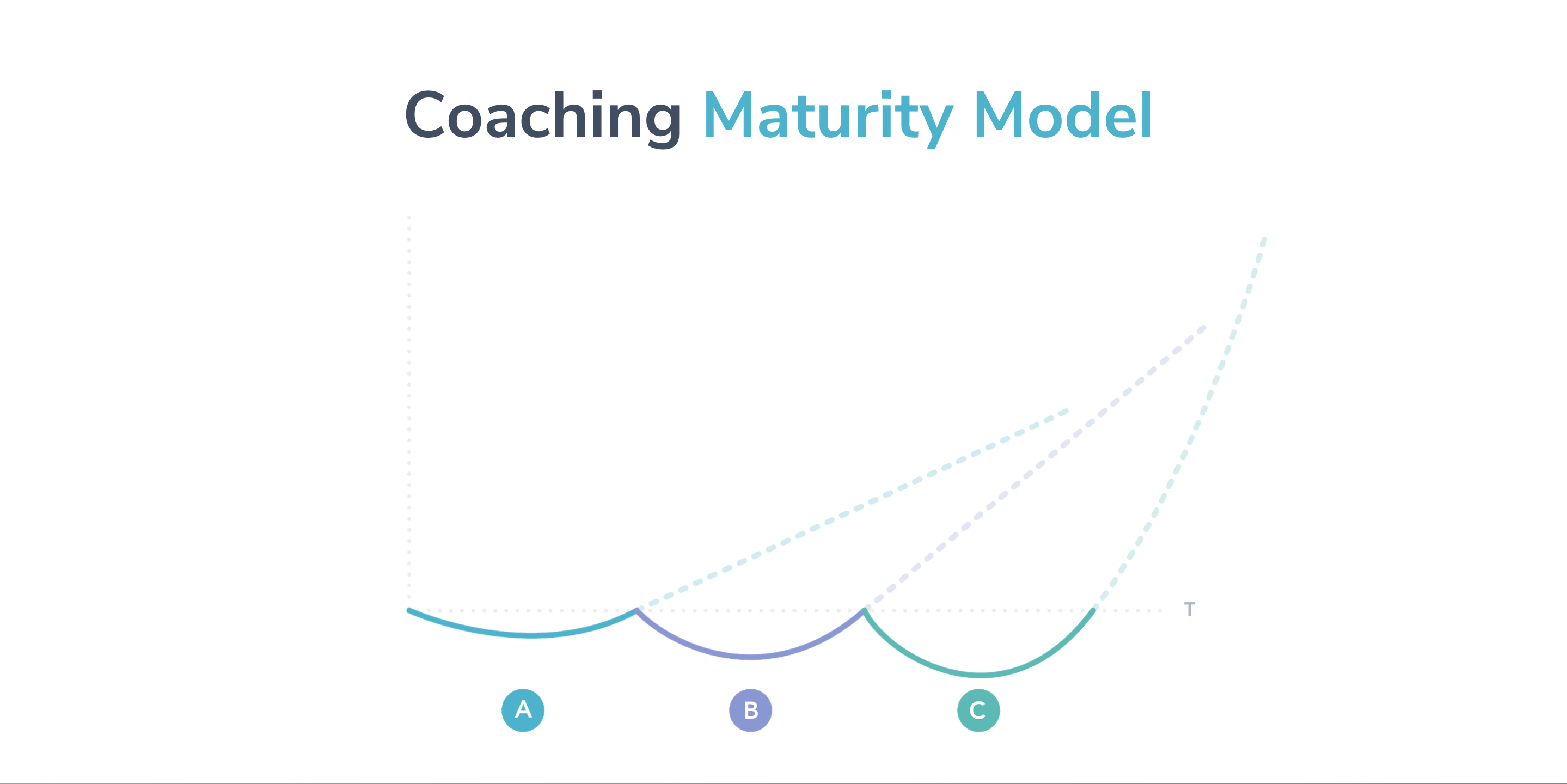
This helps identify the funding and revenue trajectory for successful venture-backed startups.
Not every company experiences the same “first five years,” though, so we use ARR, employee count, or customer count as proxy. Where is your org? Find your peer group in the image below.
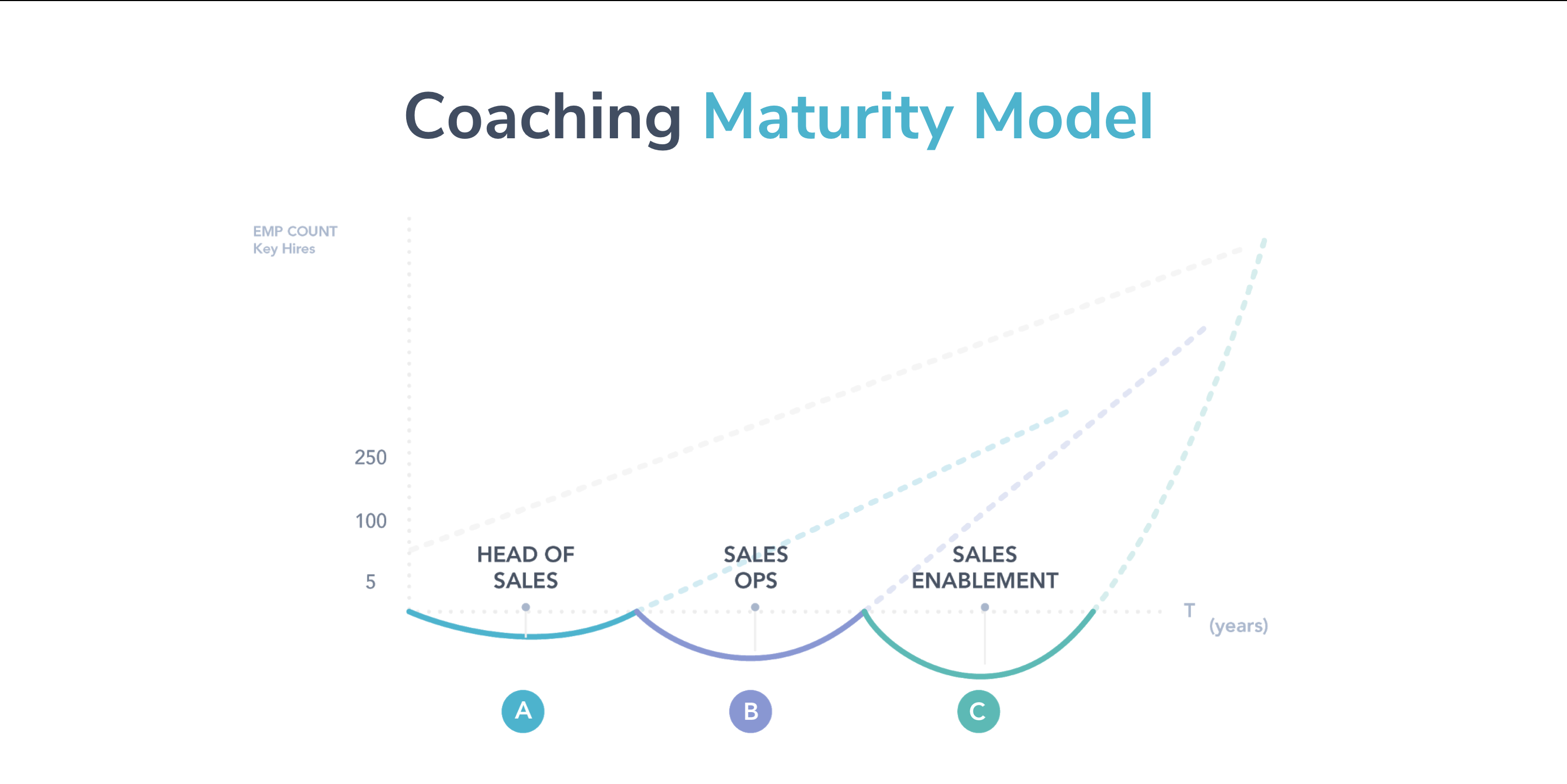
Notice that at Early Stage, a company has a Sales team but nothing more. As they move into the Growth Stage, they develop an Ops team. Then, as they approach maturity, they (finally) hire a Sales Enablement Manager and develop a Sales Enablement framework.
Now, in this next image, we’ve highlighted the most common best practices from companies at these 3 distinct phases of maturity.
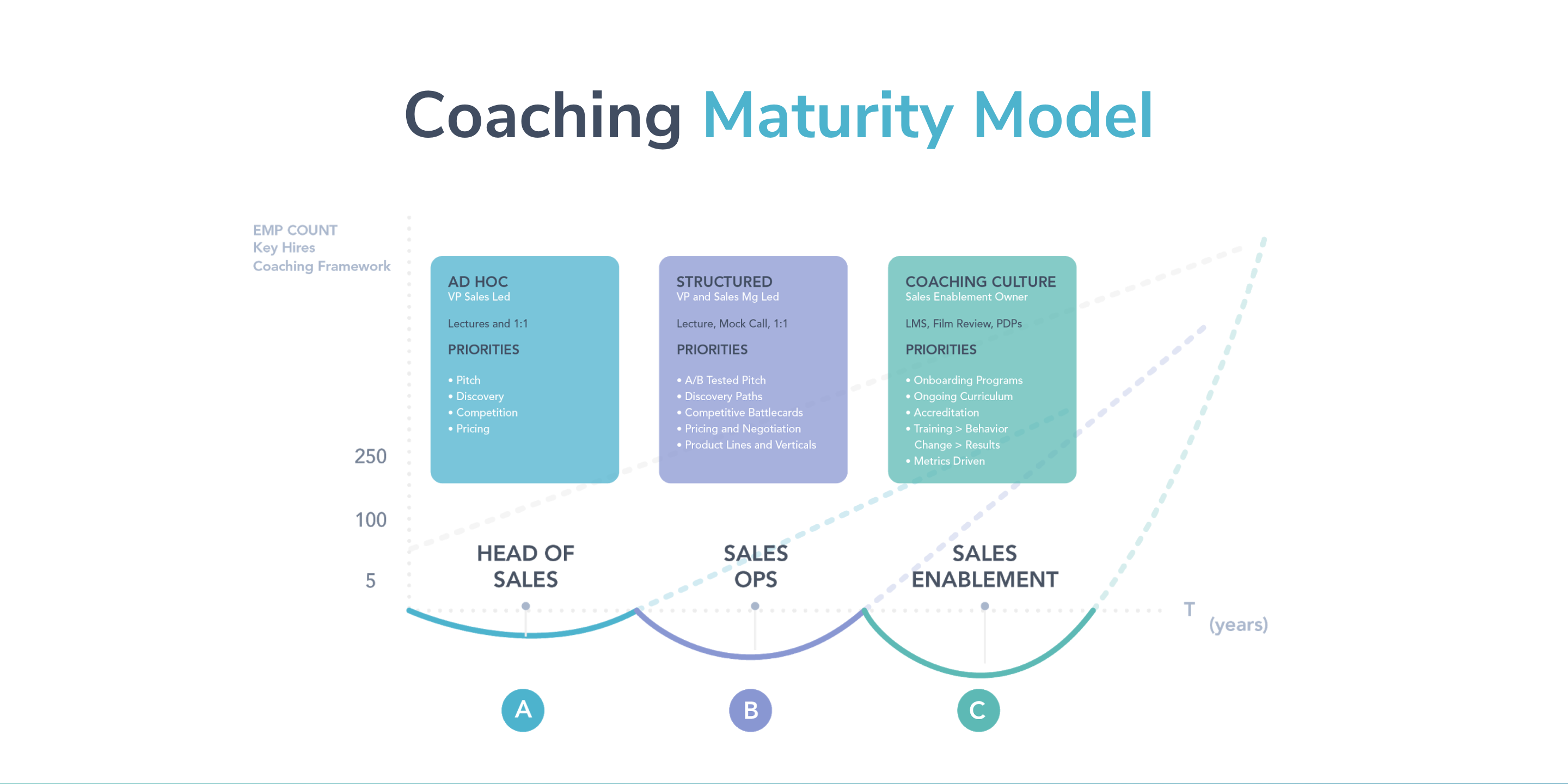
Keep in mind, these aren’t all-encompassing lists. They’re a collection of the best of the best by segment.
Meaning…
Not every item on the list might get done at one org, but if you aspire to be best in class, this is a very strong starting point for you.
Now, let’s talk about coaching culture and how you can create one that takes you to Sales Enablement best practice (and beyond).
3 Maturity Checkpoints for Your Coaching Culture
Let’s deep dive these 3 maturity checkpoints to provide a litmus test for your own coaching culture.
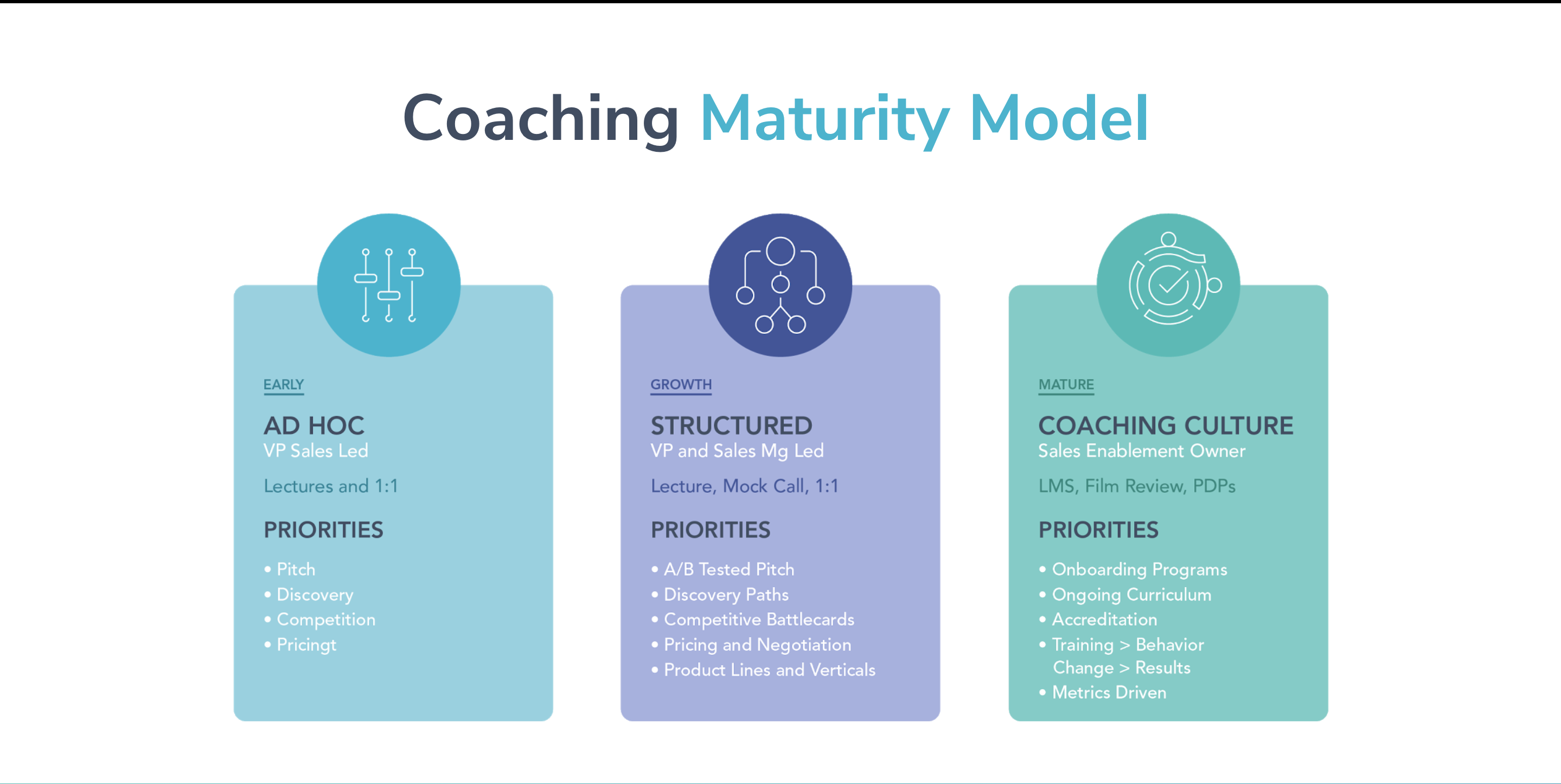
Early-Stage Coaching Culture
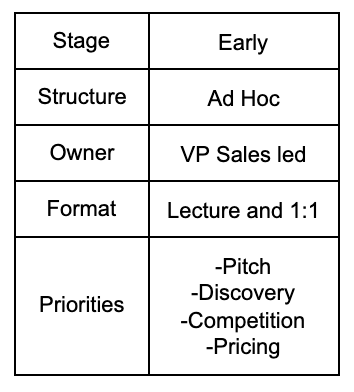
You’ll see the early developments in a coaching model tend to happen ad hoc, or in the moment.
Sales Leaders will invite the team to a group session from time to time, but most of the training takes place on or after calls. It’s almost always focused on deal execution, and rarely talks to skill development or practice. We’re coaching the deal, but not coaching the rep.
Focus tends to be on the basics: get every member of the team proficient in some basic talk tracks and then go fight for your lives!
Growth-Stage Coaching Culture
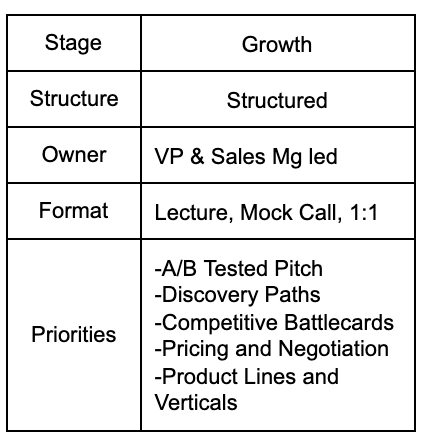
As your company grows and matures, you’ll add some scaffolding around your VP Sales.
This second layer of team leads or pure managers can shoulder some of the load. This allows you to be a little more proactive and planned in your approach.
Weekly, recurring sessions start to develop. You create a few tangible assets (like mock call guides or sample role play exercises.) Your product and market develop, creating a need for segmented messaging.
Mature-Stage Coaching Culture
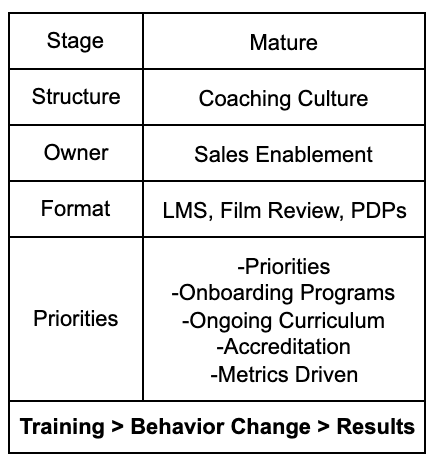
Most readers might get discouraged from this final table. Keep in mind, this represents publicly traded (or on their way) companies, with entire enablement teams built out to develop this program.
“We just raised a hundred million dollars, we’re going to hire a hundred reps in the next six months!” is the rallying cry for this stage.
Watch your initiatives take shape. You’re adding structure (from process and from tech.) You move from loose guidelines to actual curriculums. All skills and sessions are graded, rep progress is tracked, and the most mature orgs are creating individualized coaching plans at scale.
OK, But How Do I Actually Get Started?
Where do we go from here?
The answer is easier than you expect. Break your coaching framework into four key pieces. Make a simple decision on each bucket, and take action.
This is a journey of a thousand miles, so take that first step. The following will outline four areas where you can immediately make an impact this week!
4 Basic Elements of a Successful Coaching Culture
The four basic elements to any coaching culture come down to:
- Your onboarding program
- The format for ongoing development
- What role your managers play
- How focused your personal development plans become.
In the following section, you’ll find a basic breakdown of each area.
1. Onboarding
New-Hire Onboarding takes place from your first days and typically lasts anywhere from 3 weeks to 90 days.
You’ll see the ratio of classroom time to field time move from 100% on day 1 to <1 hr on your final day.
Sessions will cover everything from the founder’s vision, to basic pitch and sales training, to product and competitive understanding, as well as introductions to the rest of your team and company.
Rapid growth companies are starting to catch on, when it comes to seeing ROI, to the value of reducing ramp time.
If you can create an onboarding experience that removes a single month from ramp, you can add a month of full quota attainment for every rep you hire this year.
RELATED: The Ultimate Guide to Sales Productivity
Think about it…
Multiply the number of reps to be hired this year by an average monthly quota to find the potential impact to revenue.
In real life, you can accomplish this by simply getting more specific on what reps do in their first three months.
Want to hear our secret? Replace non-productive shadow time with a pre-built list of best practice calls.
We all make the same mistake: you slave over the lecture deck, you down three cups of coffee before the session, and you use every war and sports metaphor you can think of to deliver a high-impact, PERFECT training session.
But during the new hire’s other 7 hours that day?
“Go sit with Kat. She’s been here the longest; she’s the best. Learn her moves.”
And so it begins: the latch-key training that 80s moms perfected, leaving their kids home in front of MTV.
Meanwhile, you have a 20% win rate and a 30% no show rate. There’s less than a 10% chance that call you’re about to shadow is worth a damn. Join in and listen to your top sales rep fume about internal politics, while prospect X bails on the call again. Do you really have any idea at all what your new reps are doing with the majority of their day? No chance.
There is a better way: record all calls through your native functionality.
I promise, I’m not pitching Chorus. Every legitimate screenshare product offers basic call recording. Turn it on by default and record every meeting to rep’s personal storage.
If you win a deal, send your trainer/manager the first call’s recording. Use this list of highly productive calls (they all turned into buyers!) to build your shadow list.
Reps watch calls in tight calendar blocks instead of wandering the floor looking for a call to jump on. You get better calls reviewed, more calls reviewed, and less time spent!
Easiest win available.
RELATED: Why Everybody Hates Cold Calling… And Why That’s Good News For You
2. Ongoing Development
What happens after the first 90?
You can’t expect reps to be self-sufficient by now. Industry benchmark shows a 7 month ramp… but the dirty secret is that’s just your comp plan.
Real-life ramp takes significantly longer and most reps never actually get to a place where they’re averaging above quota. In fact, you’re modeling 70-80% attainment of the cumulative goal, but less than 30% of the individuals on your team are actually hitting plan!
Time to get busy.
The most important steps here come down to:
- Source the topics
- Align on format
- Assign and enforce ownership
This gives people fits, but can actually be a rewarding and enjoyable experience. If done correctly, it can build alignment, create goodwill in and across departments, and improve your outcome this year more than you know.
Here’s how:
Create a 12-month training calendar that highlights both Top Down and Bottom Up coaching topics.
Review the company’s strategic goals and OKRs for this year. Should any of them come with sales training attached? (Think launching new products, rolling out methodology, etc., etc.) Chances are, if it’s important enough to hit the Exec Initiative List, it’s worth training on.
Then, survey the team. Ask the reps and managers alike: “What do you want to learn this year?”
Don’t make it exclusively about selling your product. Invest in your people. Democratizing the curriculum like this creates buy-in from your team. Also guess what: they’re not asking you to teach them stuff they’re already good at! If your reps ask for help with a specific skill, help them.
Now that you’ve got a basic calendar and curriculum together, it’s time for format. There are some simple options available, and we recommend keeping it fresh by changing up.
For starters, just use the table below for a simple start.
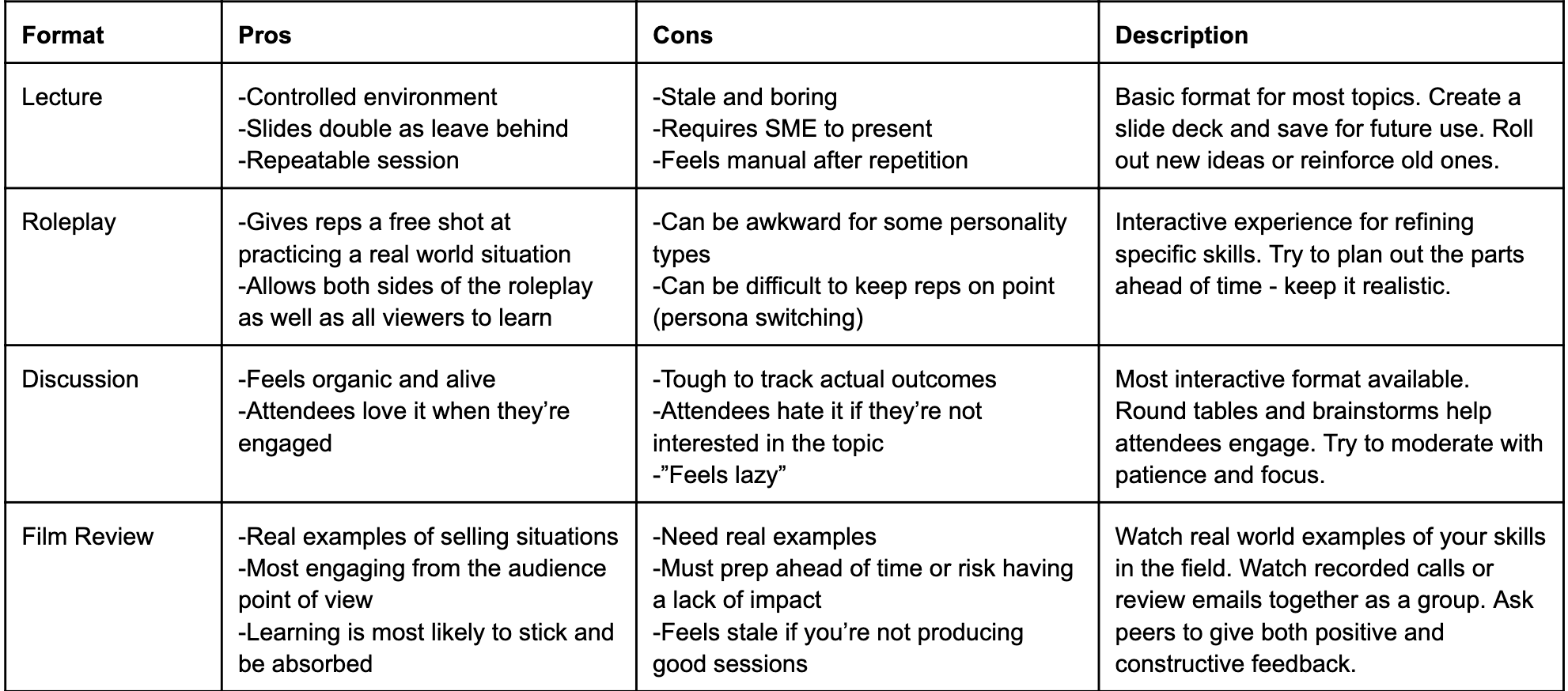
The final decision is around ownership.
You should change up the presenter to keep it fresh. Also, nominating reps to lead sessions will help keep their peers’ attention and also increase the lecturer’s knowledge retention.
So keep mixing it up. Just make sure every session has an owner who is prepared with training materials and takeaways.
RELATED: 40+ of the World’s Best Sales Training Programs to Get Your Team Into Shape
3. Managers as Coaches
Our third bucket is around the role of the front-line sales manager.
This can either be the beginning of a fantastic and long-lasting mentor/mentee relationship, or it can result in wildly nasty Glassdoor reviews.
It’s important. So why is it so broken?
It goes back to the Success Paradox outlined earlier.
The more successful you are, the less experienced your team becomes. You hire BDR right out of college, promote to AE within a year, and then promote again to MidMarket or Manager before they’ve even seen three years in the field.
They’ve never been coached, and they’ve never coached.
RELATED: How to Turn Your Sales Managers into Effective Coaches
In fact, ask yourself if you have a single authority figure on your sales team with a teaching or mentoring background. It’s the blind teaching the blind!
Actually “solving” this remains an elusive task, so let’s focus on a simple step to improve.
You just need to make a few very basic decisions:
- What is your rep/manager meeting cadence?
- What sales methodology are you using?
- Do you block time during 1:1s for coaching?
Meeting Cadence. How often does a rep and a manager meet? What is the goal of each meeting? Is this listed anywhere? Are there instructions for prep and ownership? At Chorus, we do 1:1s on Mondays, Film Review on Tuesday and Thursday, and a group Forecast call on Friday.
Sales Methodology. Use a basic framework to inspect deals — and use the same framework every time to create consistency. Use it long enough and you might actually get good at it and influence a few deals in a positive way! Google it, you don’t need more words from me on this. Just make sure that every time you’re inspecting a deal, you use the same framework. Don’t make your reps guess what you’re going to ask for. Help create a consistent experience, so all the hard focus is directed at the task at hand.
RELATED: The Sales Methodology Blueprint: How To Choose The Right One For Your Business
1:1s. Decide where you want your team to live on this spectrum. Do you go for walks and talk about stuff outside of work? Do you review the forecast and make sure pipeline is clean? Do you talk strategy on strategic deals and make sure the big ones are in shape? Do you reserve the last third of your 1:1 to review a call or email from the previous week and make sure the rep is learning and growing as a result of working with you?
4. PDPs — The Final Frontier
This last section might feel like more of a teaser than actionable advice. This section was born from conversations with the absolute top experts in the field.
We worked with people like Charlie Besecker from Qualtrics, Jake Reni at Adobe, Evan Robinson at DataRobot, Jerry Pharr with Outreach, the teams from Klaviyo, Zoom, Namely, and on and on.
Best-in-class Enablement programs move from ad hoc to structured lesson plans, and from fleeting, moment-in-time exercises, to programmatic coaching curriculums focused on tracking and improving actual scores in real life.
The holy grail has been defined and the gauntlet laid out:
- Tell me the courses you’re teaching.
- Track learning at the rep and course level.
- Prove that behaviors are actually changing in real life.
- And then show me that quota attainment, win rate, and revenue per seller are all increasing as a result.
That’s all, thank you.
So how do you even begin something like this? Hire for it. Buy it. Pay a consultant, or hire a firm. (You can email me, and I’ll connect you with the best ones out there.)
If you’re on the mature side, my honest advice is to bite the bullet, set aside a real chunk of budget, and find yourself a seasoned enablement veteran to build out a real function.
In the Meantime, Do 4 Simple Things to Create Your v1
List every session a new hire needs to be considered “trained.” This is your onboarding program.
List two company initiatives that will require training this year. Add the two skills you think are most lacking on your sales team today. This is your ongoing training plan.
Decide if your managers are responsible only for the deals or for rep training as well. List clear expectations and share with them. This is your managers’ coaching program.
Decide if you’re going to track progress this year or not. A simple table is a start: Where are your reps now and then again twice more this year. With or without this fourth step, print these answers out and you’ve got the framework for your coaching plan over the next twelve months.
Back to you. Where is your enablement program? What’s the #1 improvement you’d like to make starting today?







